ADAPTIVE EQUIPMENT
Adaptive equipment is used to compensate for a physical limitation, to promote safety, and to prevent joint injury.
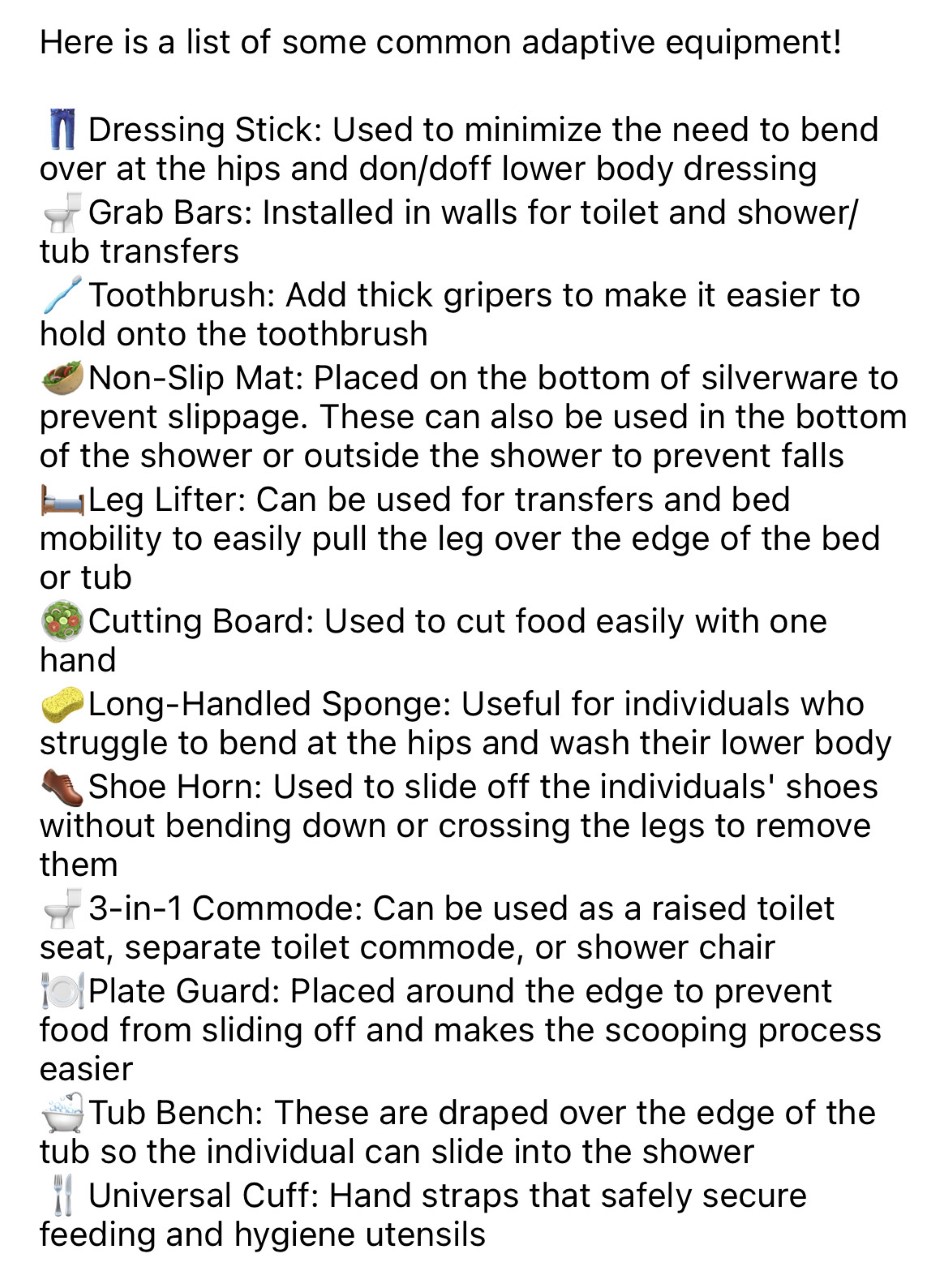
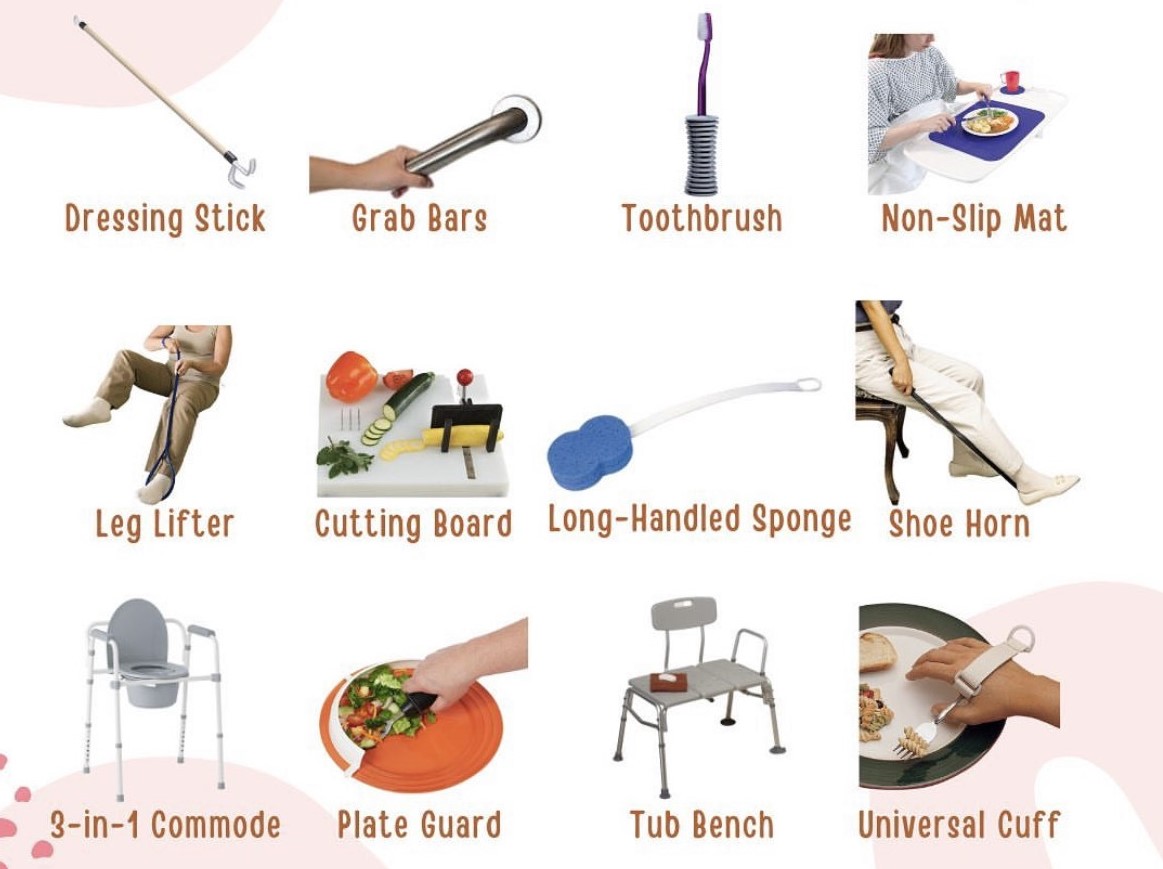
Adaptive Eating Utensils and Accessories
Adaptive eating utensils are used by people who have problems grasping standard utensils. Conditions such as arthritis, Parkinson’s disease, CVA, multiple sclerosis, and numerous others cause deficits in fine motor skills and tactile sensation that make grasping and manipulating utensils difficult. Without adaptations, the simple task of eating becomes a major chore or even impossible for people with disabilities. The following chart will review a variety of adaptive eating utensils, as well as adaptive cups, plates, bowls, and other accessories that people with disabilities might use during meals.
| Item | Description | How Item is Used | Photo/Video |
| Large handle utensils | Spoons, forks and knives with large handles made from hard plastic or soft foam material. | These utensils enlarge the grasping surface so a person with limited grasp or hand strength can hold the utensils with more ease. | A woman demonstrates the use of built-up handled utensils. |
| Weighted utensils | Spoons, forks and knives with large handles that have weights inside. The handles are usually covered with a vinyl coating. | Weighted utensils help increase the proprioceptive input that the utensil gives to the user, helping to reduce tremors and improve control during eating. |  |
| Angled utensils | Spoons and forks constructed with an angle in the shaft to bend the bowl or tines toward one side or the other. Utensils may be angled at 45 degrees or 90 degrees. Some angled utensils are adjustable to allow for any angle. | People with limited upper extremity range of motion use angled eating utensils to compensate for the lack of range. Angled utensils are especially useful for people with limited supination. | A woman uses an angled fork to feed herself.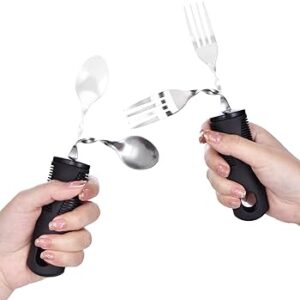 |
| Swivel utensils | Spoons and forks constructed with a larger or built-up handle that contains a swivel point in the end closer to the bowl or tines. The metal shaft closest to the bowl or tines is connected to the swivel point and bent down to allow the bowl or tines to swing with gravity. | The spoon swivels to keep the utensil level to prevent spills due to hand tremors. This utensil is particularly helpful for people who have Parkinson’s, hand tremors and weakness, or poor coordination. The built-up handle provides a more secure grip for users with limited grip strength. | A woman uses a high-tech swivel spoon to eat. |
| Lightweight utensils | Spoons, forks and knives constructed out of lightweight plastic and metal materials. These utensils usually come with adapted plastic handles that are easy to grasp. | Lightweight utensils are useful for people who have upper body weakness and functional range of motion. | 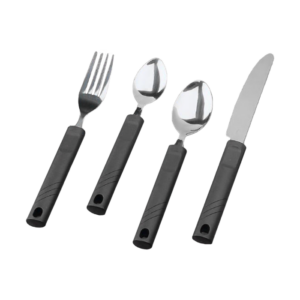 |
| Coated spoons | Spoons that have a vinyl coating over the bowl. | Coated spoons are used with people, especially children, who have oral hypersensitivity. |  |
| Rocker knife | A sharp knife that has a curved blade. The handle may be similar to a table knife or may be T shaped. | Rocker knives are used by people with hand weakness, arthritic deformities, and people who only have the use of one hand. | A boy demonstrates how to use a rocker knife to cut food. |
| Knife/fork combo | This utensil consists of a rocker knife with tines on the end of the blade. | The knife/fork combo utensil is used by people who have the use of one hand only. The rocker knife portion is used to cut food and the tines to poke food and bring it to the mouth. | 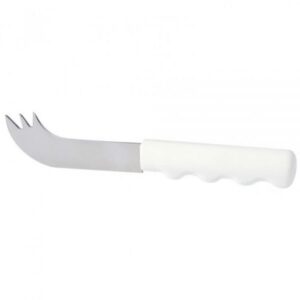 |
| Roller knife | A roller knife has a round, rolling blade, similar to a pizza cutter. | This type of knife is used by people who have hand and upper extremity weakness, fine motor coordination deficits, or the use of one hand only. |  |
| Universal cuff | The universal cuff consists of a thick vinyl or leather pocket that fits within the palm of the hand. The pocket is attached to a Velcro closure strap. The strap is used to attach the cuff to the palm of a person’s hand and a utensil is placed in the pocket. Universal cuffs may be incorporated into a wrist support for hand and wrist positioning. | Universal cuffs are used by people with limited hand mobility and function, including people with SCI, TBI, CVA, MS, and other diagnoses. The cuff holds the utensil in place so the user does not have to have a functional grasp to control the utensil. | A woman demonstrates self-feeding using a universal cuff with a spoon. |
| Right angle pocket | A right-angle pocket is a utensil pocket that is mounted to a right-angle bar. When the bar is slid into a universal cuff pocket, it positions the right-angle pocket at a right angle to the palm. | The right-angle pocket is an accessory to the universal cuff. It allows the utensil to be placed in a more natural position for eating. People who use universal cuffs may also use right angle pockets. | 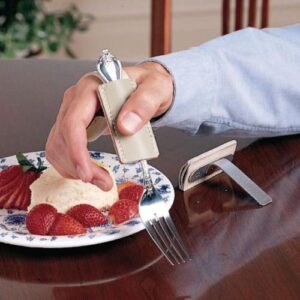 |
| Foam tubing | Foam tubing is cylindrical foam with a bore hole through the center. Foam tubing is manufactured in a variety of sizes. | Foam tubing is used to build up the handles of regular eating utensils. A piece of foam tubing is cut to size and slid over the handle of the utensil. Foam tubing may be used by anyone who has hand weakness, limitations in grasp, or difficulty holding on to metal utensils. | 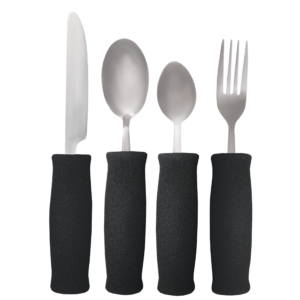 |
| Nosy cup | A plastic cup with a cut-out in the lip to accommodate the nose. | Nosy cups are used by people who cannot tilt their heads back to drink. The cut out in the cup makes room for the nose, eliminating the need to tip the head. | A woman demonstrates drinking from a nosy cup.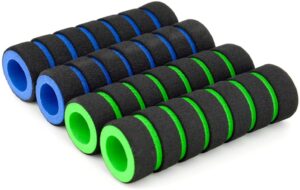 |
| Dysphagia cup | This cup is slanted from the base and has an angled lip. Dysphagia cups often have two handles. | Similar to the nosy cup, the dysphagia cup allows a person to drink without tilting the head back. Dysphagia cups were designed specifically for people with swallowing problems to reduce the risk of choking and aspiration. | A woman demonstrates drinking from a dysphagia cup. |
| Long spout cup | A cup with a lid that has a long drinking spout. | Long spout cups are used by people who have difficulty moving liquids to the back of the mouth in preparation for swallowing. The design of the cup helps to prevent liquids from dribbling out of the mouth. | 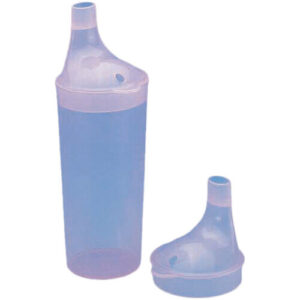 |
| One way straw | A clear plastic straw that has a tip with a one-way valve built in. | When a person drinks from a one-way straw, the valve prevents liquid from flowing out of the straw and back into the cup. One way straws are used by people who have poor oral motor skills or weak oral muscles. | Demonstration of a one-way straw. |
| Drinking straw holder | A flat piece of metal with rounded edges and holes drilled through. A metal clip at one end holds the straw holder on the edge of a cup or glass. A straw can be placed through any of the holes. | Straw holders are used to hold straws in place at the correct angle for drinking. They are used by people with limited head and neck mobility. |  |
| Suction plate and bowl | A plate or bowl with suction cups or a vinyl suction mat attached to the base. When the suction devices are activated, they hold the plate or bowl in place. | Suction plates and bowls are used by people who have difficulty holding dishes while eating, including people who have limited grasp and people who have the use of one hand only. | A baby attempts to move a suction bowl. |
| Scoop dish | A plate, bowl, or elongated dish with the lip curved inward. An alternate design is a plate with the lip extended to the inside, creating a lip around the inside of the plate. | When a person loads a utensil while using a scoop dish, he or she can push the utensil against the lip of the dish, aiding in loading food on to the utensil. Scoop dishes are used by people with limited upper extremity mobility and grasp. | Advertisement for a scoop plate. |
| Sectioned dish | A plate with tall sides and partitions through the middle, dividing the plate into sections. | Sectioned dishes prevent food from sliding on the plate and mixing together. They are used by people who have difficulty loading food utensils due to limited mobility, people with visual impairments, and people with oral sensory sensitivity. |  |
| Plate guard | A curved piece of plastic or metal with clips around the bottom edge. The clips attach to the edge of a plate, positioning the guard around a portion of the plate’s food surface. | A plate guard prevents food from sliding off a plate when it is scooped or cut. Plate guards are used by people with limited upper extremity mobility or people with visual impairments. | A woman demonstrates the use of a plate guard, along with a universal cuff, for self-feeding. |
| Non-slip placemat | A non-slip placemat is a placemat made of non-skid material. Dycem and Posey grip are two of the more common brand names for this material. | A non-slip placement prevents dishes from sliding on the table during meals. People with poor upper extremity coordination or visual impairments use non-slip placemats. | Advertisement for a non-slip placemat. |
| Redware | Adapted utensils, dishes and cups manufactured in a patented shade of red, produced by Maddah, Inc. | Redware is specially designed for use by people with Alzheimer’s disease. The red color of the dishes draws attention to the food, while the built-up utensil handles, cup design, and scoop dishes aid people with the motions needed to participate in self-feeding. | 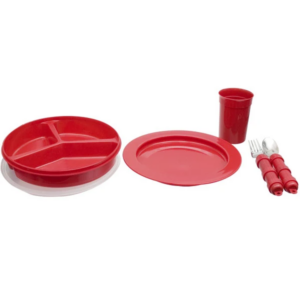 |